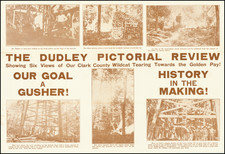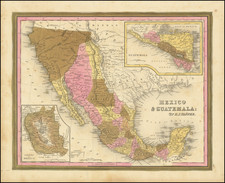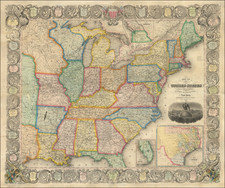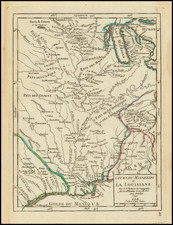Fine example of the first separately printed sea chart of Matagorda Bay, published in the Portulano de la America Septentrional, under the auspices of the Direccion De Hidrografia in Madrid.
As noted by Streeter this map of Bahia de S. Bernardo is:
The first separately engraved map of St. Bernardo Bay [with] a large 'Bahia de S. Bernardo' and a small 'Lago de S. Bernardo' adjoining, into which flows 'Ro. Colorado o de Cañas.' There are also legends for 'Ila de S. Francisco,' and 'Barra de S. Bernardo.' On modern maps this is Pass Cavallo between Matagorda Island and Matagorda Peninsula.
Alonso Álvarez de Pineda first mapped the Texas coastline in 1519. Guido de Lavazares landed at Matagorda Bay in 1558, surveyed the northern Gulf Coast, and claimed the region for King Charles V. In 1690, Manuel José de Cárdenas y Magaña mapped Matagorda Bay as part of the Llanos-Cárdenas expedition of 1690. As early as 1820 plans were made to establish a port at the site of the future town of Matagorda, but none developed, since silt deposited in the bay by the Colorado River made a port impractical at that time. Settlement by Anglo-Americans began in 1822, when the schooner Only Son landed immigrants for Stephen F. Austin's colony at the mouth of the Colorado.
The Portulano de la America Septentrional, was one of the Spanish Admiralty's last great works on North America. Intended as an Atlas of all the Spanish harbors in North and Central America and the Caribbean, it became a work of primary importance during the Spanish Enlightenment.
The Portulano was prepared under the supervision of José Joaquín Ferrer y Cafranga (1763-1818). In the early 1790s, Ferrer resided in Cadiz, the headquarters of the Armada Real. While he still worked as a merchant, he became attached to the Armada's San Fernando Observatory. Ferrer became closely acquainted with the leading Spanish explorers and cartographers of the era, including Dionisio Alcalá Galiano and Cosme Damián de Churruca y Elorza. He also gained the notice of Admiral Jose de Mazarredo y Salazar, who in addition to being a legendary battle commander was one of Spain's greatest hydrographers. Mazzaredo was a driving force of the Enlightenment in Spain, committed to modernizing the navy and employing the most sophisticated scientific technology and methods to its operations.
Ferrer was recruited by Mazarredo and the explorer Vicente Tofiño de San Miguel to play a key role in a grand cartographic endeavor, unprecedented in the history of the Spanish Empire. Up to this time, due to Spain's official policies of cartographic secrecy, very few hydrographic surveys of Spanish colonial ports were ever published. The Armada relied on foreign and often very outdated maps, and Spain's participation in the American Revolution highlighted the urgency of acquiring accurate geographical and hydrographical intelligence.
As part of his Enlightenment reforms, in 1787, King Charles III lifted most of the restrictions on map publication. Inspired by the great sea atlases recently issued by the French and British navies, Mazarredo and Tofiño were determined to oversee the creation of accurate charts that would be published and disseminated to naval commanders. The first priority would be to update the knowledge of the coasts of the Spanish Main, the West Indies and the Gulf of Mexico. As it stood, the Spanish Navy had access to some fine manuscript surveys, although much of their hydrographic intelligence was fragmentary or outdated. With respect to the high-quality existing surveys, such as Ciriaco Ceballos' mapping of the northern coast of Cuba (1788), Ferrer supervised the drafting of manuscript sketches into finely precise charts fit for publication.
In 1792, Mazarredo and Tofiño decided, with the blessing of Antonio Valdés, the Minister of the Navy, to dispatch two scientific mapping expeditions to the Americas in order to gain the required intelligence necessary to realize the project. First, Churrucca was charged with mapping the coastlines of various islands and harbors between Trinidad and Cuba. Second, Joaquín Francisco Fidalgo was charted with surveying the coast of the Spanish Main and Central America from Trinidad to Costa Rica. Ferrer was instrumental in establishing the scientific standards and techniques by which these surveys would be conducted.
It was during this period that Mazzaredo officially organized the Navy's cartographic activities under the auspices of a single agency, founding the Dirección de Hidrografía in 1797. This closely followed the Britain's move to establish the Admiralty's Hydrographic Office in 1795.
As Churrucca and Fidalgo made progress on their endeavors, they regularly sent manuscript charts to Cadiz. Ferrer helped to supervise the publication of many of these charts as separately issued 'Cartas Esfericas'. Amazingly, in spite of the turmoil caused by the ongoing Napoleonic Wars, the surveyors completed their respective missions by 1805.
Churrucca and Fidalgo's charts, along with other high-quality Spanish surveys, were then prepared for publication as part of the Portulano de la America Setentrional, envisaged as a grand sea atlas of Colonial American waters in the manner of J.F.W. Des Barres' Atlantic Neptune (London, 1775-81).
The Portulano de la America Setentrional was printed in Madrid by the Dirección de Hidrografía in 1809 and featured 121 charts, sectioned into 4 parts: 1) Puertos de la Islas Antillas (14 plates); 2) Puertos de las Costas de Tierra-Firme, Florida y seno Mexicano (36 plates, including 9 charts of harbors in today's United States); 3) Puertos de la Isla de Cuba (34 plates); and finally, Puertos de las Islas de Santo Domingo y Jamaica (22 plates).
The Portulano de la America Setentrional was printed during the brutal French occupation of Spain and the Peninsular War (1807-14), which saw the gradual liberation of Iberia. Given these circumstances, it is somewhat amazing that the Portulano was ever issued at all. As it turned out, very few copies were printed and there was little opportunity to promote what was a great masterpiece of scientific hydrography. Consequently, the Portulano de la America Setentrional never received the recognition it deserved. The work was reissued in Madrid in 1818, and another edition was printed in Mexico City in 1825. The content of the 1818 Madrid edition is identical to the 1809 edition, save for the addition of the line "Aumentado y corre-gido [sic] en 1818" to the title page. The Mexico City edition was entirely re-engraved on new plates and each chart featured altered titles.
José Joaquín Ferrer y Cafranga (1763-1818)
José Joaquín de Ferrer y Cafranga was a Spanish Basque cartographer and astronomer, and was one of the last great figures of the Ilustración Borbonica, or the Spanish Enlightenment. He was one of the fathers of modern scientific cartography in the Spanish Empire. While his achievements are not popularly known, Ferrer was widely respected and immensely influential in academic circles in both Europe and America.
Ferrer was born into an affluent and well-connected family in Pasajes de San Pedro, in the Basque Country. He was the older brother of the politician Joaquín María de Ferrer y Cafranga (1777-1861), who served as Prime Minster of Spain and Mayor of Madrid. Encouraged to seek his fortune as a merchant in the colonial trade, in 1780, he joined the Real Compañía Guipuzcoana, and set sail for Venezuela. While en route, his vessel was intercepted by Admiral Rodney's British naval squadron, and Ferrer was taken to England (Britain and Spain were then at war). He was paroled and while in London he had the opportunity to gain formal training in astronomy and surveying, as well as gaining a fluent command of the English language. Ferrer subsequently returned to Spain and reconnected with the mercantile communities.
In 1787, Ferrer sailed for Lima, Peru, and not long after his arrival, met with considerable success as a commercial trader. He took advantage of his extensive business travel to refine his skills in astronomy and surveying. While on a trip to Mexico, he notably calculated the precise geographic position and heights of several of region's highest peaks, including Jalapa, Perote and Orizaba.
As already discussed, Ferrer spent most of the 1790s in Cadiz assisting the Armada Real in their endeavors leading to the production of the Portulano de la America Setentrional. However, his work was increasingly overshadowed by grander political events. Ferrer, who held distinctly liberal beliefs, became disaffected by the conservative direction of the Spanish government, and its increasingly close relationship with Napoleon Bonaparte, whom Ferrer considered to be a tyrant. Believing that he could no longer serve under the new political regime, he set sail for America in 1799.
For the next 14 years, Ferrer was based in New York, and while earning a lucrative living as a merchant, found ample time to pursue his passions in astronomy and geography. He traveled widely, notably descending the Ohio and Mississippi rivers and making two trips to Cuba, as well as visits to Hispaniola, Puerto Rico, and the Virgin Islands. He employed the most sophisticated equipment such as Dolland's Reflecting Telescope and Arnold's Chronometer to view and record astronomical phenomena such as the solar eclipse of 1806 and the flight of a comet the following year. He also measured the latitude and longitudes of various locations in the United States, including New York, Philadelphia, Pittsburgh and New Orleans, as well as places in the Caribbean. Ferrer also calculated the diameter of the moon and the solar parallax. His papers on astronomy won him great acclaim in the academic community, and in 1809, several were published within America's most prestigious scientific journal, the Transactions of the American Philosophical Society.
In 1813, Ferrer traveled to London to study at the Greenwich Observatory, where he became acquainted with some of the Britain's leading intellectuals. The following year he studied at the Institute de France in Paris. Shortly thereafter, Ferrer returned to Spain, where he commenced work on the Portulano de los Estados Unidos.
While the Portulano was in production in Madrid, Ferrer dedicated himself full-time to the pursuit of academic projects. He became a fellow of the Real Academia de la Historia and the Real Sociedad Vascongada (Royal Basque Society). He maintained extensive correspondence with Churucca, the Spanish astronomer Felipe Bauza, and the internationally celebrated scientific luminaries Jérôme Lalande, Jean-Baptiste-Joseph Delambre, François Arago, Pierre-Simon de Laplace and Alexander von Humboldt. While not widely known today, Ferrer's work was heavily cited by leading scholars even long after his death. Notably, Alexander von Humboldt relied significantly on Ferrer's astronomical observations when writing his Essai Politique sur L'Ile de Cuba (Paris, 1826). Ferrer retired to Bilbao in 1817, and died on May 18, 1818. Unfortunately, it is likely that he never saw a completed example of the Portulano de los Estados Unidos, of which there are only a few known surviving examples.
The Dirección de Hidrografía, or the Directorate of Hydrographic Works, was established in 1797. Its roots were in the Casa de Contratación, founded in 1503 in Sevilla, which housed all the charts of the Spanish Empire and oversaw the creation and maintenance of the padrón real, the official master chart. The Casa, now in Cadiz, was shuttered in 1790, but Spain still needed a hydrographic body. In response, the Dirección was created in 1797. One of its first projects was the publication of charts from the Malaspina Expedition (1789-1794). The Dirección oversaw not only publication, but also surveying. The Dirección was abolished in the early twentieth century, when their work was distributed to other organizations.










![[Manuscript Map of Oil Development at High Island, Texas]](https://storage.googleapis.com/raremaps/img/small/66465.jpg)


![[Matagorda Bay: Pictorial Letter Sheet]](https://storage.googleapis.com/raremaps/img/small/40810.jpg)
